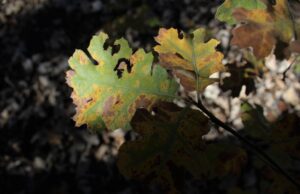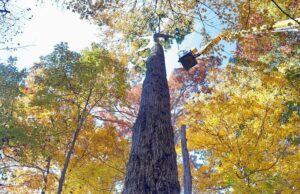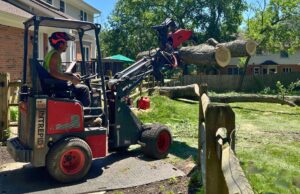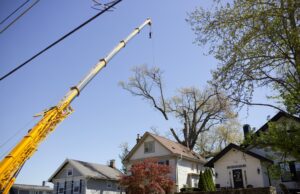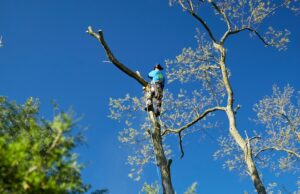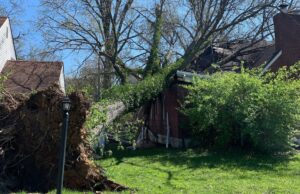Trees in Southwest Ohio and Northern Kentucky provide numerous benefits to yards, neighborhoods, and cities. They provide shade, cut down on energy costs, improve the air quality, and provide a home and food for wildlife. They add to your curb appeal and are a visual reminder of seasons changing and years passing.
However, it’s sometimes necessary to remove a tree from your property. This can be a surprisingly difficult and sometimes emotional decision for many homeowners, so we’ve put together a list of some questions to ask to help you decide if your tree needs to be removed.
NOTE: Be sure that you have the right to remove the tree (Is in on your property? Do you live in a condominium? Is the tree old enough to have historical value?) before scheduling a removal.
Is the tree healthy?
If a violent storm or strong wind has just passed through, trees can be damaged or toppled. In those cases, tree removal is a matter of urgency, especially if the tree has landed on a structure or has blocked a roadway. Contact us for emergency tree removal if this is the case.
While storm damage is immediate (and usually obvious), other things can affect your tree over time. Here are some signs of tree damage and/or disease to look for in determining whether or not a tree should be cut down –
- Pests and diseases can slowly harm and/or kill your tree. If the pest or disease has done enough damage or might possibly spread to other nearby trees, the tree might need to be removed. A tree care professional will be able to inspect your trees and tell you if this is the case.
- If you notice a lot of dead branches on your tree, or mushrooms or other fungi growing near the roots, this may be evidence of internal rot or root disease.
- If the roots have been damaged by a lawnmower, animals, or construction, it can affect how the tree gathers nutrients and water. Sometimes a tree cannot recover from root damage; it will decline and eventually die.
- The bark of the tree falling off and not growing back is another sign of a tree in distress.
- A topped tree not only looks bad, but it can cause the tree to send up multiple, weak shoots from the topped branches. A topped tree is a stressed tree and sometimes does not survive this outdated and extreme pruning method.
If you notice any of the above issues, contact a tree care professional to have the health of your tree assessed. In extreme cases, a tree will have to be removed.
Is the tree in the wrong location?
Unfortunately, this is a common homeowner issue. Different types of trees need different growing conditions (full sun or full shade, for instance), and trees often grow larger than intended, or too close to a building. Or maybe it is causing too much mess with seeds, acorns, or leaves dropping.
If trees are planted too closely together, this can affect their health and growth. In this case, the trees might benefit from nearby trees being removed.
If any construction or landscaping has been done to your home or yard lately, there is a chance that a tree’s roots have been damaged or the ground around it has been disturbed. This often harms the tree to the point that the only viable solution is to remove the tree.
Tree roots go wherever there is moisture. Oftentimes they upend sidewalks or driveways, or find their way into sewer systems or building foundations, creating costly problems.
Is the tree causing safety concerns?
Combining nature and technology often causes conflicts. This is evident when trees block sightlines to important signage (like a stop sign), driveways, sidewalks, or roads, or when the branches grow too close to wires. Sometimes this can be remedied by pruning, but sometimes the only safe solution is to remove a tree.
Leaning trees are a cause for concern as well. Some tilt is fine, but too much might signal a bigger problem, such as root damage. If you fear that your tree is in danger of falling over, contact a tree care professional right away.
After storms, the most noticeable damage is from fallen trees or broken limbs, but trees that don’t have either of those signs can still be dangerous. Large branches could have broken off but not fallen, which can cause injury and extensive damage if they fall on a person, home or car. If the tree has been heavily damaged from a storm, you may notice the trunk splitting or branches cracking. Safety concerns are high as the tree is unstable.
If part of the tree (over 25%) is dead or dying, or the entire tree is dead, it should be removed for safety reasons. The tree or branches could fall, causing injury, and if the tree was diseased or pest-ridden, it could spread to other parts of your property, including other trees.
Still not sure if you should remove a tree? Book a professional inspection
If you’ve read through all of the above and are still not sure if your tree needs to be removed, it’s time to call in a tree care professional.
Skilled professionals are trained to recognize a tree that can be saved and one that needs to be removed. If it is in the wrong location, is a safety concern, or is dying, the tree should be removed, and the arborist can suggest a different tree to take its place, if the conditions are favorable.
Sometimes, all a tree needs is treatment or pruning to keep it disease-free and strong.
Don’t forget that the best way to keep a tree healthy and safe is regular care and maintenance. Contact us today if you would like to schedule or discuss a tree inspection or removal.

